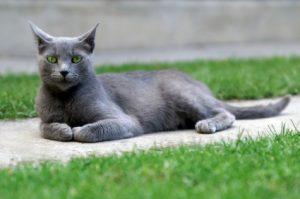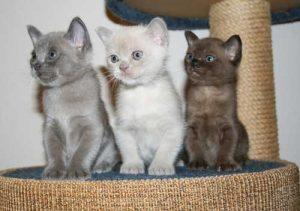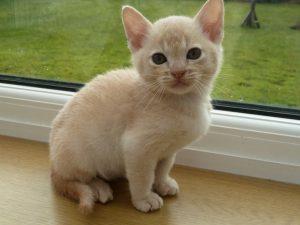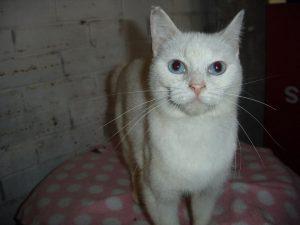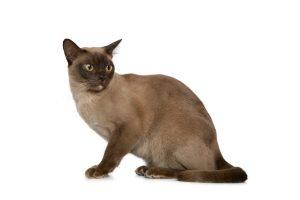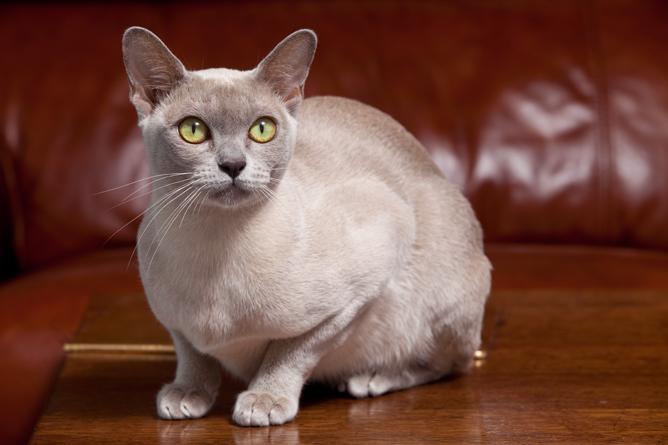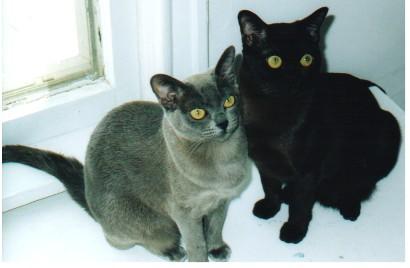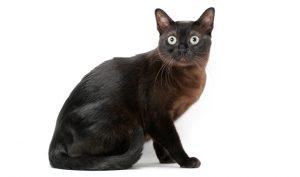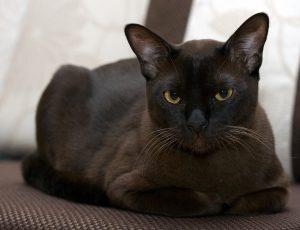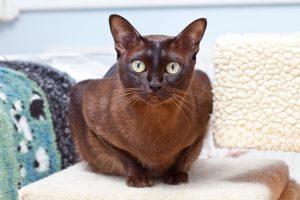Burmese Cat
The Burmese is a domestic cat breed indigenous to Burma, owing its development to the US and the UK. Its dynamic, friendly nature and pleasant disposition make it an adorable house pet.
Quick Information
Physical Appearance & Size
| Body Type: | Medium sized |
| Physical Description: | British Burmese: Long body; wedge-shaped head; large, pointy ears; tapered muzzle, long legs and neat, oval paws;American Burmese: Stocky built; comparatively broader head; short and flat muzzle; wide ears; legs and tails in proportion to the body and round paws |
| Litter Size: | 6 on an average |
| Height: | 10 to 12 inches |
| Weight (Size): | Males: More than 12 pounds; Females: 8 to 12 pounds |
Colors & Patterns
| Coat Type: | Short, glossy and fine with a satin like finish |
| Color: | Originally dark brown or sable but at present in other solid colors like champagne, platinum, and blue spread uniformly over its body |
| Pattern: | Tortoiseshell |
| Eyes: | Almond shaped ( British Burmese); Round ( American Burmese) with gold or green color depending on what coat it has |
Other Characteristics
| Average Life Span/ Life Expectancy: | 10 to 17 years |
| Temperament/ Behavioral Characteristics: | Playful, spirited, intelligent, energetic, affectionate |
| Lap Cat: | Yes |
| Shedding: | Minimal |
| Vocalization/ Sounds: | Persistent, having a soft and sweet voice |
| Good with Children: | Yes |
| Are Burmese Cats Hypoallergenic: | Yes |
| Country: | Burma ( Developed in U.K, and U.S.A) |
| Competitive Registration/ Qualification: | TICA, CFA, AACE, FIFe, CCA-AFC, ACF |
History
The present day Burmese is said to be a descendant of Wong Mau, a small-sized, walnut-brown female cat, thought to be a chocolate-colored Siamese breed, imported to the United States from Burma by Dr. Joseph Cheesman Thompson in 1930.
Thompson started selective breeding, crossing Wong Mau with a seal point Siamese named Tai Mau, imported from Thailand ( as he could not find any similar male cat in the United States), to produce a litter of brown kittens. She was further mated with her son, Yen Yen Mau, and the litter of dark brown kittens, thus produced, became the founding stock of te Burmese cat.
Though formally recognized in 1936 by the Cat Fanciers’ Association, after a decade the recognition was suspended since extensive breeding with Siamese breeds, affected the originality of the Burmese. Several breeders of American origin however attempted in improving the breed’s standards. In 1954, the suspension finally ended,
The demand for these cats in the United Kingdom was gradually increasing, with the felines included in the breeding program being of different body-builts. Some of them were also imported from the United States. Three true generations of this breed had developed in U.K. by 1952 and attained recognition by the GCCF (Governing Council of the Cat Fancy).
The two cat associations dedicated towards the improvement of the Burmese cat breed in the U.K. are the Burmese Cat Society (1979) and the Burmese Cat Club (1955).
Though both these types–the British and American, are not recognized as distinct breeds by most of the cat registries, those distinguishing them refer to the British variant as European Burmese.
Certain cat breeds possess the Burmese gene like the Rex Breeds, Asian cats and Singapura cats (which also come with a ticked tabby pattern). It is responsible for the creation of other breeds including Tonkinese, Burmilla, and Bombay.
Color variations
- Dark Brown was the original color of this breed known by various names in different countries like brown in U.K. and Australia, seal in Newzealand and sable in U.S.A
- The first Burmese with a blue coat was born in the U.K.
- Champagne colored cats (recognized as chocolate in the United Kingdom) were first seen in the United States where the cats had a honey beige body color and a gold-tan hue on its underside.
- The Burmese with a platinum coat (lilac in the U.K.) developed IN 1971, where the color pattern is silver-gray coupled with a light fawn.
- Cinnamon, caramel, apricot and fawn varieties of this breed evolved in Newzealand during the 1980s
- Russet (dark brown with a tinge of reddish orange), a new color variation developed in 2007 in Newzealand.
Personality Traits of the Burmese at a glance
- High spirited, playful and energetic
- Enjoys human company
- Possesses a dog-like bonding with its owner
- Has a high level of curiosity, involving itself in every activity its inmates do like reading a newspaper, cooking or watching television
- A perfect lap cat, loving to squeeze into his owner’s lap, caressed with affection or enjoy a snuggle in his bed at night
- The female Burmese, in particular, has a queen-like attitude, demanding attention and preferring to be in charge of things, while the males have a more relaxed nature
- Emerges as the perfect playmate for kids provided the latter does not roughly handle them
- Has a soft and sweet voice, with a soothing “meow”, fond of enjoying a hearty interaction with its family
- Good and gentle towards guests
- Detests being left alone for prolonged periods
- Has a high level of intelligence which sharpens as the breed matures
Who is the Burmese Cat Good For
- Households in need of an amicable and gregarious pet that would keep them amused all day long
- People who wouldn’t mind a cat interfering into every aspect of their personal life
- Owners looking for a cat as faithful as a dog
- Those who would remain home all day long, or at least have other pets to give these cats company
- Cat lovers on the lookout for a perfect lap cat, whom they can cuddle all day long and enjoy stroking their short, silky body hugging coat.
Care
- Brush your cat’s soft, short coat using a rubber brush, for removing dead hairs
- Keep its eyes clean by wiping the corners with a soft, moist cloth
- Brush its teeth once a week to keep dental infections at bay
- See to it that its ears are free from any discharge by cleaning them with cotton balls or a moist cloth dipped in an equal mixture of warm water and apple cider vinegar
- Bathe your Burmese when it gets dirty
- Cleanliness of its litter box is a must
Diabetes: This breed in general and the British Burmese, in particular, are more prone to this disease.
Flat-chested kitten syndrome: This condition where the thorax (extreme cases) or the lower part of the chest (mild case) gets flattened was believed to occur among the Burmese cats, though some studies have denied of this fact.
Teething disorder: This is visible in kittens, particularly those with U.K. bloodlines, where the second teeth eruption brings in a lot of discomforts to the young ones, causing them to tear at their face to get relief from pain.
Hypokalaemia: This is a genetic disorder marked by low levels of serum potassium.
Can you train the Burmese easily
Owing to their charming and adorable nature, training them would be a cake walk. You can teach your cat whatever you please like sitting, fetching a toy, rolling over, walking on a leash or even using the toilet. Channelize its intelligent mind positively and teach it some amusing tricks with which it may keep you entertained.
Feeding
Your Burmese cat’s diet should be a combination of dry cat food, wet food, dry cat biscuits and an occasional bite of snacks. Though an adult cat can eat two times a day, curb it to once a day in case, they have weight issues.
Interesting Facts
- Coco, a Burmese cat, was rescued by neighbors after being trapped in a wall cavity for 18 days without food and water.
- The Burmese breed is said to have its roots attached to Thailand, as depicted in several works of art in the ancient time, where they are referred to as the Thong Daeng or copper cats, living around Thai temples.

